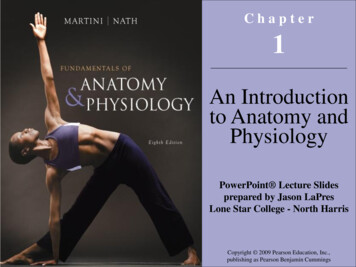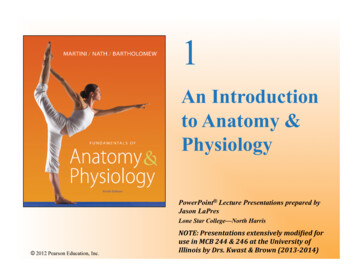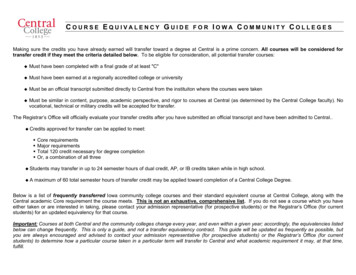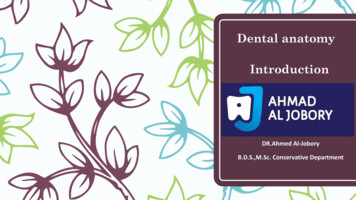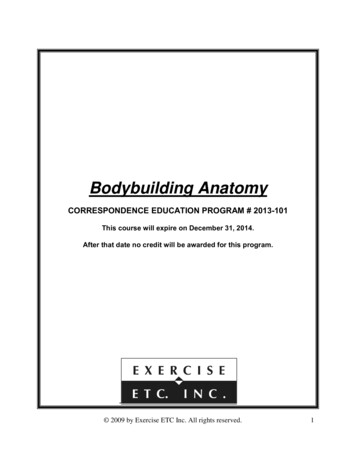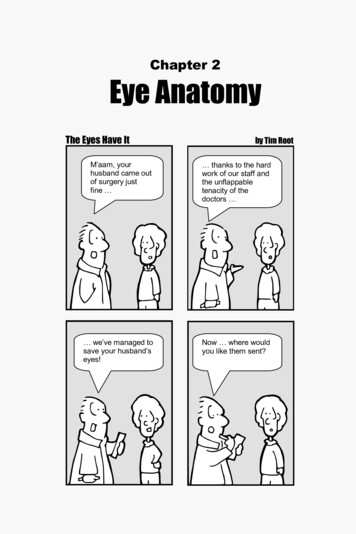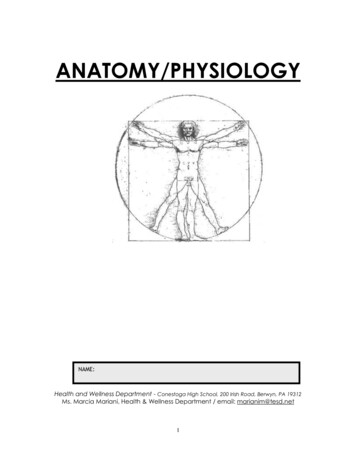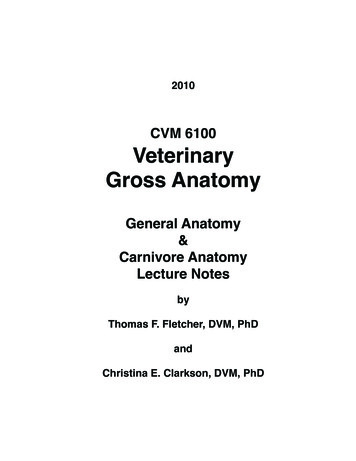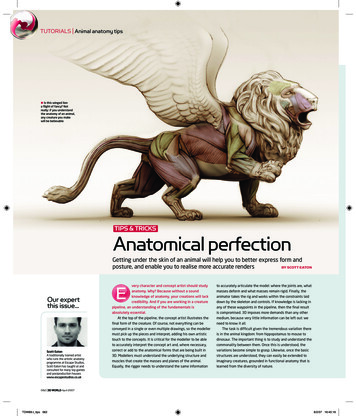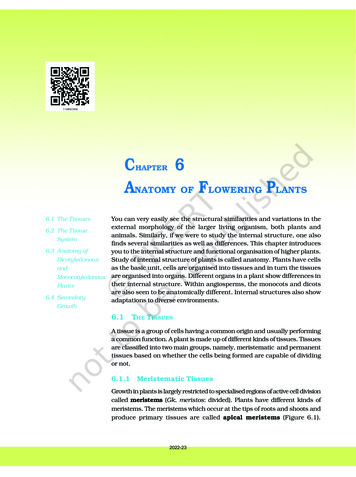
Transcription
84BIOLOGYC HAPTER 6ANATOMY OF FLOWERING PLANTS6.1 The Tissues6.2 The TissueSystem6.3 Anatomy ofDicotyledonousandMonocotyledonousPlants6.4 SecondaryGrowthYou can very easily see the structural similarities and variations in theexternal morphology of the larger living organism, both plants andanimals. Similarly, if we were to study the internal structure, one alsofinds several similarities as well as differences. This chapter introducesyou to the internal structure and functional organisation of higher plants.Study of internal structure of plants is called anatomy. Plants have cellsas the basic unit, cells are organised into tissues and in turn the tissuesare organised into organs. Different organs in a plant show differences intheir internal structure. Within angiosperms, the monocots and dicotsare also seen to be anatomically different. Internal structures also showadaptations to diverse environments.6.1 THE TISSUESA tissue is a group of cells having a common origin and usually performinga common function. A plant is made up of different kinds of tissues. Tissuesare classified into two main groups, namely, meristematic and permanenttissues based on whether the cells being formed are capable of dividingor not.6.1.1Meristematic TissuesGrowth in plants is largely restricted to specialised regions of active cell divisioncalled meristems (Gk. meristos: divided). Plants have different kinds ofmeristems. The meristems which occur at the tips of roots and shoots andproduce primary tissues are called apical meristems (Figure 6.1).2022-23
ANATOMY OF FLOWERING PLANTS85Central cylinderCortexLeaf primordiumShoot apicalMeristematic zoneProtodermInitials of centralcylinderand cortexRoot apicalmeristemAxillary budDifferentiatingvascular tissueInitials ofroot capRoot capFigure 6.1 Apical meristem: (a) Root (b) ShootRoot apical meristem occupies the tip of a root while the shoot apicalmeristem occupies the distant most region of the stem axis. During theformation of leaves and elongation of stem, some cells ‘left behind’ fromshoot apical meristem, constitute the axillary bud. Such buds are presentin the axils of leaves and are capable of forming a branch or a flower. Themeristem which occurs between mature tissues is known as intercalarymeristem. They occur in grasses and regenerate parts removed by thegrazing herbivores. Both apical meristems and intercalary meristems areprimary meristems because they appear early in life of a plant andcontribute to the formation of the primary plant body.The meristem that occurs in the mature regions of roots and shoots ofmany plants, particularly those that produce woody axis and appearlater than primary meristem is called the secondary or lateral meristem.They are cylindrical meristems. Fascicular vascular cambium,interfascicular cambium and cork-cambium are examples of lateralmeristems. These are responsible for producing the secondary tissues.Following divisions of cells in both primary and as well as secondarymeristems, the newly formed cells become structurally and functionallyspecialised and lose the ability to divide. Such cells are termed permanentor mature cells and constitute the permanent tissues. During theformation of the primary plant body, specific regions of the apical meristemproduce dermal tissues, ground tissues and vascular tissues.2022-23
86BIOLOGY6.1.2Permanent TissuesThe cells of the permanent tissues do not generallydivide further. Permanent tissues having all cellssimilar in structure and function are called simpletissues. Permanent tissues having many differenttypes of cells are called complex tissues.Intercelluar space(a)Thickened cornersProtoplasmVacuoleCell wall(b)PitsLumenThickcell wallLumenThickcell wallA sclereidA fibre(c)Figure 6.2 Simple tissues :(a) Parenchyma(b) Collenchyma(c) Sclerenchyma6.1.2.1Simple TissuesA simple tissue is made of only one type of cells.The various simple tissues in plants areparenchyma, collenchyma and sclerenchyma(Figure 6.2). Parenchyma forms the majorcomponent within organs. The cells of theparenchyma are generally isodiametric. Theymay be spherical, oval, round, polygonal orelongated in shape. Their walls are thin and madeup of cellulose. They may either be closely packedor have small intercellular spaces. Theparenchyma performs various functions likephotosynthesis, storage, secretion.The collenchyma occurs in layers below theepidermis in most of the dicotyledonous plants. It isfound either as a homogeneous layer or in patches.It consists of cells which are much thickened at thecorners due to a deposition of cellulose,hemicellulose and pectin. Collenchymatous cellsmay be oval, spherical or polygonal and oftencontain chloroplasts. These cells assimilate foodwhen they contain chloroplasts. Intercellular spacesare absent. They provide mechanical support to thegrowing parts of the plant such as young stem andpetiole of a leaf.Sclerenchyma consists of long, narrow cellswith thick and lignified cell walls having a few ornumerous pits. They are usually dead and withoutprotoplasts. On the basis of variation in form,structure, origin and development, sclerenchymamay be either fibres or sclereids. The fibres arethick-walled, elongated and pointed cells,generally occuring in groups, in various parts ofthe plant. The sclereids are spherical, oval orcylindrical, highly thickened dead cells with very2022-23
ANATOMY OF FLOWERING PLANTS87narrow cavities (lumen). These are commonly found in the fruitwalls of nuts; pulp of fruits like guava, pear and sapota; seedcoats of legumes and leaves of tea. Sclerenchyma providesmechanical support to organs.6.1.2.2TracheidComplex TissuesThe complex tissues are made of more than one type of cellsand these work together as a unit. Xylem and phloem constitutethe complex tissues in plants (Figure 6.3).Xylem functions as a conducting tissue for water andminerals from roots to the stem and leaves. It also providesmechanical strength to the plant parts. It is composed of fourdifferent kinds of elements, namely, tracheids, vessels, xylemfibres and xylem parenchyma. Gymnosperms lack vessels intheir xylem. Tracheids are elongated or tube like cells withthick and lignified walls and tapering ends. These are dead andare without protoplasm. The inner layers of the cell walls havethickenings which vary in form. In flowering plants, tracheidsand vessels are the main water transporting elements. Vessel isa long cylindrical tube-like structure made up of many cellscalled vessel members, each with lignified walls and a largecentral cavity. The vessel cells are also devoid of protoplasm.Vessel members are interconnected through perforations in theircommon walls. The presence of vessels is a characteristic featureof angiosperms. Xylem fibres have highly thickened walls andobliterated central lumens. These may either be septate oraseptate. Xylem parenchyma cells are living and thin-walled,and their cell walls are made up of cellulose. They store foodmaterials in the form of starch or fat, and other substances liketannins. The radial conduction of water takes place by the rayparenchymatous cells.Primary xylem is of two types – protoxylem and metaxylem.The first formed primary xylem elements are called protoxylemand the later formed primary xylem is called metaxylem. Instems, the protoxylem lies towards the centre (pith) and themetaxylem lies towards the periphery of the organ. This typeof primary xylem is called endarch. In roots, the protoxylemlies towards periphery and metaxylem lies towards the centre.Such arrangement of primary xylem is called exarch.Phloem transports food materials, usually from leaves toother parts of the plant. Phloem in angiosperms is composedof sieve tube elements, companion cells, phloem parenchyma2022-23Vessels(a)Sieve poreSieve tubeelementPhloemparenchymaCompanioncell(b)Figure 6.3 (a) Xylem(b) Phloem
88BIOLOGYand phloem fibres. Gymnosperms have albuminous cells and sieve cells.They lack sieve tubes and companion cells. Sieve tube elements arealso long, tube-like structures, arranged longitudinally and areassociated with the companion cells. Their end walls are perforated in asieve-like manner to form the sieve plates. A mature sieve elementpossesses a peripheral cytoplasm and a large vacuole but lacks a nucleus.The functions of sieve tubes are controlled by the nucleus of companioncells. The companion cells are specialised parenchymatous cells, whichare closely associated with sieve tube elements. The sieve tube elementsand companion cells are connected by pit fields present between theircommon longitudinal walls. The companion cells help in maintaining thepressure gradient in the sieve tubes. Phloem parenchyma is made upof elongated, tapering cylindrical cells which have dense cytoplasm andnucleus. The cell wall is composed of cellulose and has pits through whichplasmodesmatal connections exist between the cells. The phloemparenchyma stores food material and other substances like resins, latexand mucilage. Phloem parenchyma is absent in most of themonocotyledons. Phloem fibres (bast fibres) are made up ofsclerenchymatous cells. These are generally absent in the primary phloembut are found in the secondary phloem. These are much elongated,unbranched and have pointed, needle like apices. The cell wall of phloemfibres is quite thick. At maturity, these fibres lose their protoplasm andbecome dead. Phloem fibres of jute, flax and hemp are used commercially.The first formed primary phloem consists of narrow sieve tubes and isreferred to as protophloem and the later formed phloem has bigger sievetubes and is referred to as metaphloem.6.2 THE TISSUE SYSTEMWe were discussing types of tissues based on the types of cells present.Let us now consider how tissues vary depending on their location in theplant body. Their structure and function would also be dependent onlocation. On the basis of their structure and location, there are three typesof tissue systems. These are the epidermal tissue system, the ground orfundamental tissue system and the vascular or conducting tissue system.6.2.1Epidermal Tissue SystemThe epidermal tissue system forms the outer-most covering of the wholeplant body and comprises epidermal cells, stomata and the epidermalappendages – the trichomes and hairs. The epidermis is the outermostlayer of the primary plant body. It is made up of elongated, compactly2022-23
ANATOMY OF FLOWERING PLANTS89arranged cells, which form a continuous layer. Epidermis is usually singlelayered. Epidermal cells are parenchymatous with a small amount ofcytoplasm lining the cell wall and a large vacuole. The outside of theepidermis is often covered with a waxy thick layer called the cuticle whichprevents the loss of water. Cuticle is absent in roots. Stomata are structurespresent in the epidermis of leaves. Stomata regulate the process oftranspiration and gaseous exchange. Each stoma is composed of two beanshaped cells known as guard cells which enclose stomatal pore. In grasses,the guard cells are dumb-bell shaped. The outer walls of guard cells (awayfrom the stomatal pore) are thin and the inner walls (towards the stomatalpore) are highly thickened. The guard cells possess chloroplasts andregulate the opening and closing of stomata. Sometimes, a few epidermalcells, in the vicinity of the guard cells become specialised in their shape andsize and are known as subsidiary cells. The stomatal aperture, guardcells and the surrounding subsidiary cells are together called stomatalapparatus (Figure 6.4).Epidermal cellsSubsidiary cellsChloroplastGuard cellsStomatalporeFigure 6.4 Diagrammatic representation: (a) stomata with bean-shaped guard cells(b) stomata with dumb-bell shaped guard cellThe cells of epidermis bear a number of hairs. The root hairs areunicellular elongations of the epidermal cells and help absorb water andminerals from the soil. On the stem the epidermal hairs are calledtrichomes. The trichomes in the shoot system are usually multicellular.They may be branched or unbranched and soft or stiff. They may evenbe secretory. The trichomes help in preventing water loss due totranspiration.6.2.2The Ground Tissue SystemAll tissues except epidermis and vascular bundles constitute the groundtissue. It consists of simple tissues such as parenchyma, collenchymaand sclerenchyma. Parenchymatous cells are usually present in cortex,pericycle, pith and medullary rays, in the primary stems and roots. Inleaves, the ground tissue consists of thin-walled chloroplast containingcells and is called mesophyll.2022-23
90BIOLOGY6.2.3The Vascular Tissue SystemThe vascular system consists of complex tissues,the phloem and the xylem.The xylem andphloem together constitute vascular bundles(Figure 6.5). In dicotyledonous stems, cambiumis present between phloem and xylem. Suchvascular bundles because of the presence ofcambium possess the ability to form secondaryxylem and phloem tissues, and hence are calledopen vascular bundles. In the monocotyledons,the vascular bundles have no cambium presentin them. Hence, since they do not form secondarytissues they are referred to as closed. Whenxylem and phloem within a vascular bundle arearranged in an alternate manner along thedifferent radii, the arrangement is called radialsuch as in roots. In conjoint type of vascularbundles, the xylem and phloem are jointlysituated along the same radius of vascularbundles. Such vascular bundles are commonin stems and leaves. The conjoint vascularbundles usually have the phloem located onlyon the outer side of xylem.6.3Figure 6.5 Various types of vascular bundles :(a) radial (b) conjoint closed(c) conjoint openANATOMY OF DICOTYLEDONOUSMONOCOTYLEDONOUS PLANTSANDFor a better understanding of tissueorganisation of roots, stems and leaves, it isconvenient to study the transverse sections ofthe mature zones of these organs.6.3.1Dicotyledonous RootLook at Figure 6.6 (a), it shows the transversesection of the sunflower root. The internal tissueorganisation is as follows:The outermost layer is epiblema. Many ofthe cells of epiblema protrude in the form ofunicellular root hairs. The cortex consists ofseveral layers of thin-walled parenchyma cells2022-23
ANATOMY OF FLOWERING PLANTS91with intercellular spaces. The innermostlayer of the cortex is called endodermis.It comprises a single layer of barrel-shapedcells without any intercellular spaces. Thetangential as well as radial walls of theendodermal cells have a deposition ofwater-impermeable, waxy material suberinin the form of casparian strips. Next toendodermis lies a few layers of thick-walledparenchyomatous cells referred to aspericycle. Initiation of lateral roots andvascular cambium during the secondarygrowth takes place in these cells. The pithis small or inconspicuous. Theparenchymatous cells which lie betweenthe xylem and the phloem are calledconjuctive tissue. There are usually twoto four xylem and phloem patches. Later,a cambium ring develops between thexylem and phloem. All tissues on theinnerside of the endodermis such aspericycle, vascular bundles and pithconstitute the stele.Root taxylemPithPhloem(a)Root hairEpidermisCortexEndodermisPericyclePhloem6.3.2 Monocotyledonous RootThe anatomy of the monocot root is similarto the dicot root in many respects (Figure6.6 b). It has epidermis, cortex, endodermis,pericycle, vascular bundles and pith. Ascompared to the dicot root which have fewerxylem bundles, there are usually more thansix (polyarch) xylem bundles in the monocotroot. Pith is large and well developed.Monocotyledonous roots do not undergoany secondary growth.6.3.3ProtoxylemPithMetaxylem(b)Figure 6.6Dicotyledonous StemThe transverse section of a typical youngdicotyledonous stem shows that the epidermisis the outermost protective layer of the stem2022-23T.S. : (a) Dicot root (Primary)(b) Monocot root
92BIOLOGY(Figure 6.7 a). Covered with a thin layer of cuticle, it may bear trichomes anda few stomata. The cells arranged in multiple layers between epidermis andpericycle constitute the cortex. It consists of three sub-zones. The outerhypodermis, consists of a few layers of collenchymatous cells just below theepidermis, which provide mechanical strength to the young stem. Corticallayers below hypodermis consist of rounded thin walled parenchymatouscells with conspicuous intercellular spaces. The innermost layer of the cortexis called the endodermis. The cells of the endodermis are rich in starchgrains and the layer is also referred to as the starch sheath. Pericycle isFigure 6.7 T.S. of stem : (a) Dicot (b) Monocot2022-23
ANATOMY OF FLOWERING PLANTS93present on the inner side of the endodermis and above the phloem in theform of semi-lunar patches of sclerenchyma. In between the vascular bundlesthere are a few layers of radially placed parenchymatous cells, which constitutemedullary rays. A large number of vascular bundles are arranged in a ring ;the ‘ring’ arrangement of vascular bundles is a characteristic of dicot stem.Each vascular bundle is conjoint, open, and with endarch protoxylem. Alarge number of rounded, parenchymatous cells with large intercellularspaces which occupy the central portion of the stem constitute the pith.6.3.4Monocotyledonous StemThe monocot stem has a sclerenchymatous hypodermis, a large numberof scattered vascular bundles, each surrounded by a sclerenchymatousbundle sheath, and a large, conspicuous parenchymatous ground tissue(Figure 6.7b). Vascular bundles are conjoint and closed. Peripheralvascular bundles are generally smaller than the centrally located ones.The phloem parenchyma is absent, and water-containing cavities arepresent within the vascular bundles.6.3.5 Dorsiventral (Dicotyledonous) LeafThe vertical section of a dorsiventral leaf through the lamina shows threemain parts, namely, epidermis, mesophyll and vascular system. Theepidermis which covers both the upper surface (adaxial epidermis) andlower surface (abaxial epidermis) of the leaf has a conspicuous cuticle.The abaxial epidermis generally bears more stomata than the adaxialepidermis. The latter may even lack stomata. The tissue between the upperand the lower epidermis is called the mesophyll. Mesophyll, whichpossesses chloroplasts and carry out photosynthesis, is made up ofparenchyma. It has two types of cells – the palisade parenchyma andthe spongy parenchyma. The adaxially placed palisade parenchyma ismade up of elongated cells, which are arranged vertically and parallel toeach other. The oval or round and loosely arranged spongy parenchymais situated below the palisade cells and extends to the lower epidermis.There are numerous large spaces and air cavities between these cells.Vascular system includes vascular bundles, which can be seen in theveins and the midrib. The size of the vascular bundles are dependent onthe size of the veins. The veins vary in thickness in the reticulate venationof the dicot leaves. The vascular bundles are surrounded by a layer ofthick walled bundle sheath cells. Look at Figure 6.8 (a) and find theposition of xylem in the vascular bundle.6.3.6Isobilateral (Monocotyledonous) LeafThe anatomy of isobilateral leaf is similar to that of the dorsiventral leaf inmany ways. It shows the following characteristic differences. In an2022-23
94BIOLOGYisobilateral leaf, the stomata are presenton both the surfaces of the epidermis; andthe mesophyll is not differentiated intopalisade and spongy parenchyma (Figure6.8 b).In grasses, certain adaxial epidermalcells along the veins modify themselvesinto large, empty, colourless cells. Theseare called bulliform cells. When thebulliform cells in the leaves have absorbedwater and are turgid, the leaf surface isexposed. When they are flaccid due towater stress, they make the leaves curlinwards to minimise water loss.The parallel venation in monocotleaves is reflected in the near similar sizesof vascular bundles (except in main veins)as seen in vertical sections of the leaves.6.4 SECONDARY GROWTHFigure 6.8 T.S. of leaf : (a) Dicot (b) MonocotThe growth of the roots and stems inlength with the help of apical meristem iscalled the primary growth. Apart fromprimary growth most dicotyledonousplants exhibit an increase in girth. Thisincrease is called the secondary growth.The tissues involved in secondary growthare the two lateral meristems: vascularcambium and cork cambium.6.4.1 Vascular CambiumThe meristematic layer that is responsiblefor cutting off vascular tissues – xylem andpholem – is called vascular cambium. Inthe young stem it is present in patches asa single layer between the xylem andphloem. Later it forms a complete ring.6.4.1.1 Formation of cambial ringIn dicot stems, the cells of cambium presentbetween primary xylem and primaryphloem is the intrafascicular cambium.2022-23
ANATOMY OF FLOWERING PLANTS95The cells of medullary rays, adjoining these intrafascicular cambium becomemeristematic and form the interfascicular cambium. Thus, a continuousring of cambium is formed.6.4.1.2Activity of the cambial ringThe cambial ring becomes active and begins to cut off new cells, bothtowards the inner and the outer sides. The cells cut off towards pith,mature into secondary xylem and the cells cut off towards peripherymature into secondary phloem. The cambium is generally more activeon the inner side than on the outer. As a result, the amount of secondaryxylem produced is more than secondary phloem and soon forms acompact mass. The primary and secondary phloems get graduallycrushed due to the continued formation and accumulation of secondaryxylem. The primary xylem however remains more or less intact, in oraround the centre. At some places, the cambium forms a narrow band ofparenchyma, which passes through the secondary xylem and thesecondary phloem in the radial directions. These are the secondarymedullary rays (Figure 6.9).Figure 6.9 Secondary growth in a dicot stem (diagrammatic) – stages in transverse views2022-23
96BIOLOGY6.4.1.3Spring wood and autumn woodThe activity of cambium is under the control of many physiological andenvironmental factors. In temperate regions, the climatic conditions arenot uniform through the year. In the spring season, cambium is veryactive and produces a large number of xylary elements having vesselswith wider cavities. The wood formed during this season is called springwood or early wood. In winter, the cambium is less active and formsfewer xylary elements that have narrow vessels, and this wood is calledautumn wood or late wood.The spring wood is lighter in colour and has a lower density whereasthe autumn wood is darker and has a higher density. The two kinds ofwoods that appear as alternate concentric rings, constitute an annual ring.Annual rings seen in a cut stem give an estimate of the age of the tree.6.4.1.4Heartwood and sapwoodIn old trees, the greater part of secondary xylem is dark brown due todeposition of organic compounds like tannins, resins, oils, gums, aromaticsubstances and essential oils in the central or innermost layers of the stem.These substances make it hard, durable and resistant to the attacks of microorganisms and insects. This region comprises dead elements with highlylignified walls and is called heartwood. The heartwood does not conductwater but it gives mechanical support to the stem. The peripheral region ofthe secondary xylem, is lighter in colour and is known as the sapwood. It isinvolved in the conduction of water and minerals from root to leaf.6.4.2Cork CambiumAs the stem continues to increase in girth due to the activity of vascularcambium, the outer cortical and epidermis layers get broken and need tobe replaced to provide new protective cell layers. Hence, sooner or later,another meristematic tissue called cork cambium or phellogen develops,usually in the cortex region. Phellogen is a couple of layers thick. It ismade of narrow, thin-walled and nearly rectangular cells. Phellogen cutsoff cells on both sides. The outer cells differentiate into cork or phellemwhile the inner cells differentiate into secondary cortex or phelloderm.The cork is impervious to water due to suberin deposition in the cell wall.The cells of secondary cortex are parenchymatous. Phellogen, phellem,and phelloderm are collectively known as periderm. Due to activity ofthe cork cambium, pressure builds up on the remaining layers peripheral2022-23
ANATOMY OF FLOWERING PLANTS97to phellogen and ultimately theselayers die and slough off. Bark is anon-technical term that refers to alltissues exterior to the vascularcambium, therefore includingsecondary phloem. Bark refers to anumber of tissue types, viz.,periderm and secondary phloem.Bark that is formed early in theseason is called early or soft bark.Towards the end of the season, lateor hard bark is formed. Name thevarious kinds of cell layers whichconstitute the bark.At certain regions, the phellogencuts off closely arrangedparenchymatous cells on the outerside instead of cork cells. Theseparenchymatous cells soon rupturethe epidermis, forming a lensshaped openings called lenticels.Lenticels permit the exchange ofgases between the outer atmosphereand the internal tissue of the stem.These occur in most woody trees(Figure 6.10).EpidermisComplimentarycellsCork cambiumSecondarycortex(a)(a)6.4.3 Secondary Growth inRootsIn the dicot root, the vascularcambium is completely secondary inorigin. It originates from the tissuelocated just below the phloembundles, a portion of pericycle tissue,above the protoxylem forming acomplete and continuous wavy ring,which later becomes circular (Figure6.11). Further events are similar tothose already described above for adicotyledon stem.(b)Figure 6.10 (a) Lenticel and (b) Bark2022-23
98BIOLOGYEpidermisCortexPrimary phloemCambial mCortexPrimary phloemEpidermisCortexAnnual ringVascular cambiumSecondary phloemPrimary xylemSecondary xylemSecondary xylemSecondaryphloem raysCortexFigure 6.11 Different stages of the secondary growth in a typical dicot rootSecondary growth also occurs in stems and roots of gymnosperms.However, secondary growth does not occur in monocotyledons.SUMMARYAnatomically, a plant is made of different kinds of tissues. The plant tissues arebroadly classified into meristematic (apical, lateral and intercalary) and permanent(simple and complex). Assimilation of food and its storage, transportation of water,minerals and photosynthates, and mechanical support are the main functions oftissues. There are three types of tissue systems – epidermal, ground and vascular.The epidermal tissue systems are made of epidermal cells, stomata and theepidermal appendages. The ground tissue system forms the main bulk of theplant. It is divided into three zones – cortex, pericycle and pith. The vasculartissue system is formed by the xylem and phloem. On the basis of presence ofcambium, location of xylem and phloem, the vascular bundles are of differenttypes. The vascular bundles form the conducting tissue and translocate water,minerals and food material.2022-23
ANATOMY OF FLOWERING PLANTS99Monocotyledonous and dicotyledonous plants show marked variation in theirinternal structures. They differ in type, number and location of vascular bundles.The secondary growth occurs in most of the dicotyledonous roots and stems andit increases the girth (diameter) of the organs by the activity of the vascular cambiumand the cork cambium. The wood is actually a secondary xylem. There are differenttypes of wood on the basis of their composition and time of production.EXERCISES1.State the location and function of different types of meristems.2.Cork cambium forms tissues that form the cork. Do you agree with thisstatement? Explain.3.Explain the process of secondary growth in the stems of woody angiospermswith the help of schematic diagrams. What is its significance?4.Draw illustrations to bring out the anatomical difference between(a) Monocot root and Dicot root(b) Monocot stem and Dicot stem5.Cut a transverse section of young stem of a plant from your school garden andobserve it under the microscope. How would you ascertain whether it is amonocot stem or a dicot stem? Give reasons.6.The transverse section of a plant material shows the following anatomicalfeatures - (a) the vascular bundles are conjoint, scattered and surrounded by asclerenchymatous bundle sheaths. (b) phloem parenchyma is absent. Whatwill you identify it as?7.Why are xylem and phloem called complex tissues?8.What is stomatal apparatus? Explain the structure of stomata with a labelleddiagram.9.Name the three basic tissue systems in the flowering plants. Give the tissuenames under each system.10.How is the study of plant anatomy useful to us?11,What is periderm? How does periderm formation take place in the dicot stems?12.Describe the internal structure of a dorsiventral leaf with the help of labelleddiagrams.2022-23
Study of internal structure of plants is called anatomy. Plants have cells as the basic unit, cells are organised into tissues and in turn the tissues are organised into organs. Different organs in a plant show differences in their internal structure. Within angiosperms, the monoco
